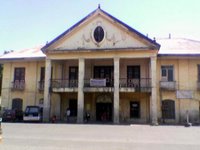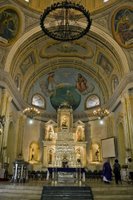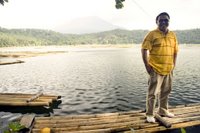 Another road trip today. It's so difficult when you don't have a digital camera so I had to rely on my mobile phone. I was in Rosales, Pangasinan this morning to do some research. And I decided to finish my work here in Bolinao right by the beach. At least the atmosphere is more relaxed. And I was able to check mail thanks to my brod Sasa Miralao who is a marine biologist at the Bolinao Laboratory of the UP Marine Science Institute (UP MSI) which has WiFi access. Hehe!
Another road trip today. It's so difficult when you don't have a digital camera so I had to rely on my mobile phone. I was in Rosales, Pangasinan this morning to do some research. And I decided to finish my work here in Bolinao right by the beach. At least the atmosphere is more relaxed. And I was able to check mail thanks to my brod Sasa Miralao who is a marine biologist at the Bolinao Laboratory of the UP Marine Science Institute (UP MSI) which has WiFi access. Hehe!It was quite a long but leisurely drive from Rosales to Bolinao. It takes you from the southeast to northwestern tip of Pangasinan. I made a stop at San Carlos City since I was attracted by its old church (above). Lo and behold! It was very much intact but there was evidence of ongoing renovation which could be potentially destructive. Will someone please tell these priests and parish pastoral councils to stop touching all these heritage churches. In fact, they were painting the old floor tiles white. Duh! That is not the way to clean tiles!

 After San Carlos was Calasiao. The old church and convento, and even the lot around it was very well- preserved. But for crying out loud, they plastered the walls of both buildings with cement! Strike two for the Archdiocese of Lingayen-Dagupan. It was then off to Binmaley (both photos on the right). Really nice church! Red brick like San Carlos and Calasiao. But when you enter, another horror renovation... modernized to look like some European church. Please, please... we have our own church heritage to be proud of here in the Philippines. Let's keep these old folksy Filipino churches Filipino! Strike three!
After San Carlos was Calasiao. The old church and convento, and even the lot around it was very well- preserved. But for crying out loud, they plastered the walls of both buildings with cement! Strike two for the Archdiocese of Lingayen-Dagupan. It was then off to Binmaley (both photos on the right). Really nice church! Red brick like San Carlos and Calasiao. But when you enter, another horror renovation... modernized to look like some European church. Please, please... we have our own church heritage to be proud of here in the Philippines. Let's keep these old folksy Filipino churches Filipino! Strike three! It was off to Lingayen, the provincial capital, which I featured in an earlier entry. Hats off to Gov. Victor Agbayani for restoring the provincial capitol. But thumbs down to the Lingayen parish priest who demolished a charming brick convento, replacing it with a new shopping arcade right beside the church! Strike four for the Archdiocese of Lingayen-Dagupan! I'm surprised Archbishop Oscar Cruz is allowing this to happen under his watch, especially since during the time he was Archbishop of San Fernando, Pampanga, he moved heaven and earth to create the Archdiocesan Archives and Museum. I hope he puts his foot down and stops this destruction from continuing in his jurisdiction. More than the jueteng, I think he should keep his eyes on the whims and caprices of these construction-frenzied priests. Again, stop touching heritage churches! And if you plan to restore them, get technical support from the Heritage Conservation Society, NCCA, NHI or National Museum.
It was off to Lingayen, the provincial capital, which I featured in an earlier entry. Hats off to Gov. Victor Agbayani for restoring the provincial capitol. But thumbs down to the Lingayen parish priest who demolished a charming brick convento, replacing it with a new shopping arcade right beside the church! Strike four for the Archdiocese of Lingayen-Dagupan! I'm surprised Archbishop Oscar Cruz is allowing this to happen under his watch, especially since during the time he was Archbishop of San Fernando, Pampanga, he moved heaven and earth to create the Archdiocesan Archives and Museum. I hope he puts his foot down and stops this destruction from continuing in his jurisdiction. More than the jueteng, I think he should keep his eyes on the whims and caprices of these construction-frenzied priests. Again, stop touching heritage churches! And if you plan to restore them, get technical support from the Heritage Conservation Society, NCCA, NHI or National Museum. Ligayen still has a lot of government buildings intact, as well as charming houses along the streets of the poblacion. One of these is the old casa municipal of the town (above). Beside it is the the provincial jail which is a heritage building itself (right). I hope Gov. Agbayani is able to convince LGUs in his jurisdiction to follow his lead.
Ligayen still has a lot of government buildings intact, as well as charming houses along the streets of the poblacion. One of these is the old casa municipal of the town (above). Beside it is the the provincial jail which is a heritage building itself (right). I hope Gov. Agbayani is able to convince LGUs in his jurisdiction to follow his lead.It was off to Alaminos City, home of the Hundred Islands National Park. And just like the rest of the churches I passed by, the interior of Alaminos has been modernized beyond recognition. But there are still a number of well-preserved houses which have been put into good use. At least these owners are doing adaptive reuse without knowing they are!
 Since it was already late, I decided to forego the Hundred Islands visit for another day. Bolinao was still quite a distance away. But the trip was most worth it. I was greeted by an old limestone church in the poblacion which looked like a fortress (left). Sasa met me there and we both went to the Bolinao Lighthouse in Patar which was about thirty minutes away (below).
Since it was already late, I decided to forego the Hundred Islands visit for another day. Bolinao was still quite a distance away. But the trip was most worth it. I was greeted by an old limestone church in the poblacion which looked like a fortress (left). Sasa met me there and we both went to the Bolinao Lighthouse in Patar which was about thirty minutes away (below).
 The view from the foot of the 1905 lighthouse was spledid. It would be nice to watch the sun set on the South China Sea from there but we didn't want to drive in the dark so we went back to town after taking some photos.
The view from the foot of the 1905 lighthouse was spledid. It would be nice to watch the sun set on the South China Sea from there but we didn't want to drive in the dark so we went back to town after taking some photos. On the way back, we stopped along a bridge to take photos of the mouth of the Balingasay River, which the Municipal Government of Bolinao declared a marine protected area in 1999. The initiative to protect this marine sanctuary came from the local government unit (LGU) for which they won the Philippine Wetlands Conservation Award in 2004. Had the LGU not stepped in, Balingasay's mangrove area could have been a part of the quarry area of a cement plant complex proposed by an international consortium of companies or damaged by environment-destructive fish pens and fish cages.
On the way back, we stopped along a bridge to take photos of the mouth of the Balingasay River, which the Municipal Government of Bolinao declared a marine protected area in 1999. The initiative to protect this marine sanctuary came from the local government unit (LGU) for which they won the Philippine Wetlands Conservation Award in 2004. Had the LGU not stepped in, Balingasay's mangrove area could have been a part of the quarry area of a cement plant complex proposed by an international consortium of companies or damaged by environment-destructive fish pens and fish cages. For dinner, we had street food at the plaza. I bought their native kakanin (rice cake) which they call binungay. It's suman (glutinuous rice cake) roasted in bamboo. They sell it in various sizes depending on the diameter of the bamboo stalk. And they have a funny way of opening it. According to the tindera (hawker) you had to smash the bamboo container by either pounding it on a rock or slicing it open with a bolo in order to eat the rice cake. So smash it we did. Hehe! Like most suman, it is best eaten with ripe mangoes or coco jam. I also had isaw baboy and manok (roasted pork and chicken intestines), mami (noodle soup) and fried chicken as well.
For dinner, we had street food at the plaza. I bought their native kakanin (rice cake) which they call binungay. It's suman (glutinuous rice cake) roasted in bamboo. They sell it in various sizes depending on the diameter of the bamboo stalk. And they have a funny way of opening it. According to the tindera (hawker) you had to smash the bamboo container by either pounding it on a rock or slicing it open with a bolo in order to eat the rice cake. So smash it we did. Hehe! Like most suman, it is best eaten with ripe mangoes or coco jam. I also had isaw baboy and manok (roasted pork and chicken intestines), mami (noodle soup) and fried chicken as well.After I checked-in, we went straight to the UP MSI so that I could check mail and type my blog entry for today. Tonight, I work on the project I need to finish. Tomorrow, I join Sasa to nearby Santiago Island to help him out with his sea cucumber experiment. Then its back to Pampanga after lunch via Zambales.
How to get to Bolinao, Pangasinan
Victory Liner and Five Star have several bus trips from Manila to Bolinao daily. Trips begin at about 7 a.m. and leave at intervals of 2 to 3 hours.



















